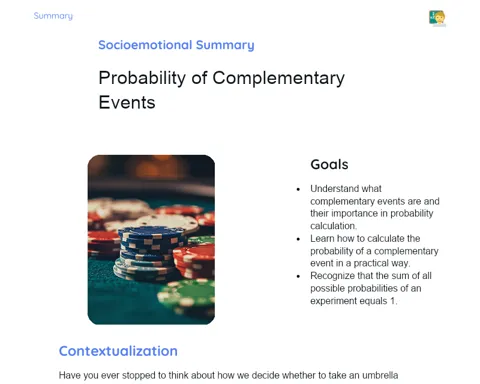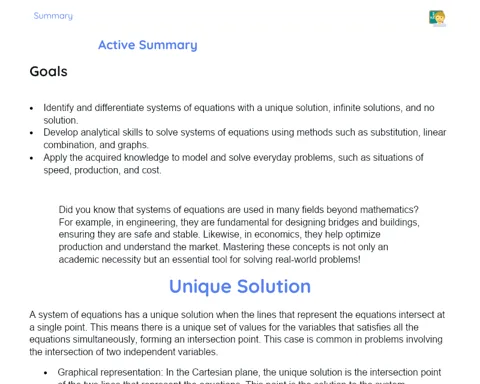TOPICS: Fractions - Addition and Subtraction
Keywords
- Fraction
- Numerator
- Denominator
- Least Common Multiple (LCM)
- Addition of fractions
- Subtraction of fractions
- Equivalent fractions
- Simplification of fractions
Key Questions
- How to identify equivalent fractions?
- What is the process to find the LCM?
- What is the procedure to add or subtract fractions with equal denominators?
- How to add or subtract fractions with different denominators?
- When and how to simplify a fraction resulting from addition or subtraction?
Crucial Topics
- Understanding of fraction as part of a whole
- Identification and use of equivalent fractions
- Determination of the LCM for different denominators
- Performing addition and subtraction with the same denominator
- Performing addition and subtraction with different denominators, using the LCM
- Simplification of fractions after addition or subtraction
Specifics: Formulas
- Addition of Fractions with equal denominators: [\frac{a}{c} + \frac{b}{c} = \frac{a + b}{c}]
- Addition of Fractions with different denominators: [\frac{a}{c} + \frac{b}{d} = \frac{a \times d + b \times c}{c \times d}] (After finding the LCM)
- Subtraction of Fractions with equal denominators: [\frac{a}{c} - \frac{b}{c} = \frac{a - b}{c}]
- Subtraction of Fractions with different denominators: [\frac{a}{c} - \frac{b}{d} = \frac{a \times d - b \times c}{c \times d}] (After finding the LCM)
- Simplification of Fractions: [\frac{a}{b} \rightarrow \frac{a \div x}{b \div x}] (Where (x) is a common divisor to (a) and (b))
NOTES: Methods and Applications
Key Terms
- Fraction: Represents one or more equal parts of a whole. It consists of the numerator (upper part, indicating how many parts of the whole are being considered) and the denominator (lower part, indicating into how many parts the whole is divided).
- Numerator: Indicates how many parts of the whole the fraction represents.
- Denominator: Indicates into how many parts the whole has been divided.
- Least Common Multiple (LCM): The smallest positive integer that is a common multiple of two or more numbers. This concept is key to adding or subtracting fractions with different denominators.
Main Ideas, Information, and Concepts
- Equivalent Fractions: Are fractions that, although different in their terms (numerator and denominator), represent the same amount. For example, (\frac{1}{2}) is equivalent to (\frac{2}{4}).
- LCM Applied: Determining the LCM is essential when we need to perform operations with fractions that have different denominators. It allows us to convert the fractions to a common base, facilitating addition or subtraction.
Topic Contents
- Addition and Subtraction with the Same Denominator: When fractions have the same denominator, we add or subtract only the numerators, keeping the denominator unchanged.
- Step by step: ( \frac{a}{c} + \frac{b}{c} = \frac{a+b}{c} )
- Finding the LCM: To add or subtract fractions with different denominators, we first find the LCM of the denominators, transform the fractions so that both have the LCM as a denominator, and then add or subtract the numerators.
- Step by step: ( \frac{a}{c} + \frac{b}{d} \rightarrow ) find the LCM of (c) and (d) ( \rightarrow ) convert to the same denominator ( \rightarrow ) add or subtract the numerators.
- Simplification of Fractions: After performing the addition or subtraction, we simplify the resulting fraction by dividing both the numerator and the denominator by the greatest common divisor to both.
Examples and Cases
- Addition with Equal Denominators: ( \frac{2}{5} + \frac{1}{5} = \frac{2+1}{5} = \frac{3}{5} ).
- Explanation: Both fractions have the same denominator (5), so we add only the numerators (2 and 1), resulting in (\frac{3}{5}).
- Addition with Different Denominators: ( \frac{1}{3} + \frac{1}{6} ).
- Explanation: First, we find the LCM of 3 and 6 which is 6. Converting each fraction to have the denominator 6, we have that ( \frac{1}{3} = \frac{2}{6} ) and ( \frac{1}{6} = \frac{1}{6} ). We add the numerators, resulting in ( \frac{2+1}{6} = \frac{3}{6} ) which simplified is (\frac{1}{2}).
- Subtraction with Different Denominators: ( \frac{3}{4} - \frac{1}{2} ).
- Explanation: The LCM of 4 and 2 is 4. Converting each fraction to have the denominator 4, ( \frac{1}{2} = \frac{2}{4} ). We perform the subtraction ( \frac{3}{4} - \frac{2}{4} = \frac{1}{4} ).
SUMMARY AND CONCLUSIONS
Summary of the most relevant points
- Fractions represent parts of a whole and are composed of a numerator and a denominator.
- Equivalent Fractions are different in appearance but equal in value.
- Least Common Multiple (LCM) is crucial for adding and subtracting fractions with distinct denominators.
- The addition of fractions with the same denominator is done by adding the numerators.
- To add or subtract fractions with different denominators, both are converted to the same denominator using the LCM.
- Simplifying the resulting fraction is important to reach the most reduced form.
Conclusions
- The ability to identify and operate with equivalent fractions is fundamental for working with additions and subtractions of fractions.
- The process of adding and subtracting fractions requires attention to the denominators, requiring equality between them for direct operation.
- Finding the LCM is an essential step to combine fractions with different denominators into a single fraction.
- Simplification is the final step to present the result clearly and precisely, facilitating interpretation and subsequent use of the fraction.
- Practicing these operations develops logical reasoning and mathematical ability, aiding in the resolution and elaboration of problems.



